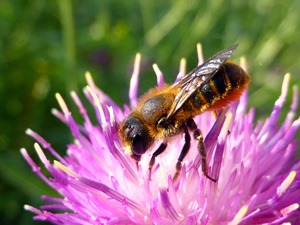Countryside changes 'more damaging' to bees than urban sprawl
Release Date 01 April 2015

Watch a Royal Society film about the research
Under-threat bees have suffered more from changes to rural landscapes over the past century than from expanding towns and cities, a new report has found.
Scientists at the University of Reading analysed records going back 80 years and found that wildlife habitats near new towns, such as Milton Keynes, supported greater insect diversity than those in more rural areas.
The findings, published in the Royal Society journal Proceedings B, are the first to show a link between insect biodiversity loss and changing land use over time, and highlight the importance of managing the wider landscape for bee conservation.
The researchers examined records of landscape change, alongside data about insect diversity, dating back to the 1930s. They found that while changes within many natural wildlife habitats had a role to play, the diversity of bee and wasp species was heavily influenced by land use changes in the surrounding areas.
While the majority of sites studied experienced a loss in species numbers, sites such as woods or heaths surrounded by arable farmland suffered far more than those where urban areas had grown up, the scientists found.
Lead researcher Dr Deepa Senapathi, from the University of Reading's Centre for Agri-Environmental Research (CAER), said urban areas could be a richer source of food and habitat than farmland.
"While concreting over the countryside may appear to be bad news for nature, we've found that progressive urbanisation may be much less damaging than intensive agriculture," she said.
"Urban areas may benefit bees more than farmland by providing a wide variety of flowering plants, providing a cosmopolitan menu for insects from spring through to autumn.
"Without a mixture of habitat and food sources, rural areas can sometimes be little better than green deserts for biodiversity" - Dr Deepa Senapathi
"Over the past century rural landscapes in Britain have become increasingly dominated by large expanses of monoculture - the growing of a single type of plant, which has helped boost crop production. But without a mixture of habitat and food sources, rural areas can sometimes be little better than green deserts for biodiversity."
Professor Simon Potts, director of CAER, University of Reading, and a co-author of the research, said: "This study highlights the need for a more joined-up environmental policy to help insect pollinators, which are critical both to our food security and farmers' profits.
"Britain's rich rural tapestry of fields, heaths, woods and grassland that existed in the 1930s has increasingly been replaced by arable farming and urban development. While many individual wildlife sites have been maintained, this is not enough. We need to encourage a mixture of diverse land uses in the wider countryside.
"Good farmers are already doing lots to help, by making smarter use of pesticides and providing varied wildlife habitats in hedgerows and field margins, for example. This is good for the environment and the beauty of our landscape, but also makes good business sense. Insect-pollinated cash crops, such as oilseed rape, beans, strawberries and apples, produce more and better-quality yields when they are pollinated properly."
The full paper, 'The impact of over 80 years of land cover changes on bee and wasp pollinator communities in England', was published on 1 April 2015 in the journal Royal Society Proceedings B.
